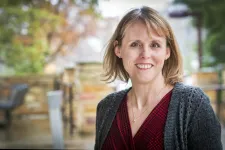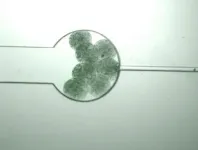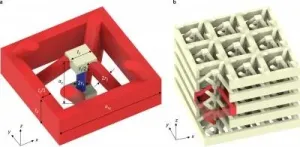Dinosaurs lived in greenhouse climate with hot summers
New climate reconstruction method provides precise picture of climate 78 million years ago
2021-06-10
(Press-News.org) Palaeoclimatologists study climate of the geological past. Using an innovative technique, new research by an international research team led by Niels de Winter (VUB-AMGC & Utrecht University) shows for the first time that dinosaurs had to deal with greater seasonal differences than previously thought.
De Winter: "We used to think that when the climate warmed like it did in the Cretaceous period, the time of the dinosaurs, the difference between the seasons would decrease, much like the present-day tropics experience less temperature difference between summer and winter. However, our reconstructions now show that the average temperature did indeed rise, but that the temperature difference between summer and winter remained rather constant. This leads to hotter summers and warmer winters."
To better characterize the climate during this period of high CO2 concentration, the researchers used very well-preserved fossils of mollusks that lived in southern Sweden during the Cretaceous period, about 78 million years ago. Those shells grew in the warm, shallow seas that covered much of Europe at the time. They recorded monthly variations in their environment and climate, like the rings in a tree. For their research, de Winter and the team used the "clumped isotope" method for the first time, in combination with a method developed by Niels de Winter.
Clumped isotopes in combination with the VUB-UU method - a revolution in geology
Isotopes are atoms of the same element with different masses. Since the 1950s, the ratio of oxygen isotopes in carbonate has been used to measure water temperature in the geological past. However, this required researchers to estimate the chemistry of the seawater, as the isotope ratio of the seawater affects the isotope ratio of the shell, which results in higher uncertainty. About ten years ago, the "clumped isotope" method was developed, which does not depend on the chemistry of the seawater and allows accurate reconstructions. But the clumped isotope method has a disadvantage: it requires so much carbonate that temperature reconstructions at a more detailed level, such as seasonal fluctuations based on shells, were not possible.
De Winter has now developed an innovative method in which measurements of much smaller quantities of carbonate are cleverly combined for temperature reconstructions. The clumped isotope method thus requires much less material and can therefore be used for research on fossil shells, which, like tree rings, hold a great deal of information about their living conditions. The method also allows carbonate from successive summers (and winters) to be aggregated for better reconstruction of seasonal temperatures. For example, Winter found that water temperatures in Sweden during the Cretaceous "greenhouse period" fluctuated between 15°C and 27°C, over 10°C warmer than today.
The team also worked with scientists from the University of Bristol (UK) who develop climate models to compare the results with climate simulations of the Cretaceous period. Whereas previous climate reconstructions of the Cretaceous often came out colder than these models, the new results agree very well with the Bristol models. This shows that variations in seasons and water chemistry are very important in climate reconstructions:
"It is very difficult to determine climate changes from so long ago on the seasonal scale, but the seasonal scale is essential to get climate reconstructions right. If there is hardly any difference between the seasons, reconstructions of average annual temperature come out differently from situations when difference between the seasons is large. It was thought that during the age of the dinosaurs difference between the seasons was small. We have now established that there were greater seasonal differences. With the same temperature average over a year, you end up with a much higher temperature in the summer.
De Winter: "Our results therefore suggest that in the mid latitudes, seasonal temperatures will likely rise along with climate warming, while seasonal difference is maintained. This results in very high summer temperatures. The results bring new insight into the dynamics of a warm climate on a very fine scale, which can be used to improve both climate reconstructions and climate predictions. Moreover, they show that a warmer climate can also have extreme seasons."
The development has far-reaching implications for the way climate reconstructions are done. It allows researchers to determine both the effect of seawater chemistry and that of differences between summer and winter, thus verifying the accuracy of decades of temperature reconstructions. For his groundbreaking research, De Winter has been nominated for both the annual EOS Pipette Prize and New Scientist Science Talent 2021.
INFORMATION:
The study by de Winter and colleagues appeared in the journal Communications in Earth and Environment on June 10th.
[Attachments] See images for this press release:

ELSE PRESS RELEASES FROM THIS DATE:
2021-06-10
Inaccessible workplaces, normative departmental cultures and 'ableist' academic systems have all contributed to the continued underrepresentation and exclusion of disabled researchers in the Geosciences, according to an article published today (Thursday 8 June) in Nature Geosciences.
The article argues that changes to both working spaces and attitudes are urgently needed if institutions are to attract, safeguard and retain people with disabilities.
Anya Lawrence, a disabled early career researcher in the University of Birmingham's School of Geography, Earth and Environmental Science and author of the piece says:
"Disabled geoscientists like myself face barrier after barrier on a daily ...
2021-06-10
People who smoke, suffer from high blood pressure, obesity, or diabetes are not only at greater risk of suffering a stroke, heart attack, or dementia. For them, the risk of being affected by depressive mood or depression also increases. The more risk factors a person has, the more likely this is. Until now, however, it was unclear whether this probability also depends on their age. Earlier studies had already shown for other diseases such as dementia or stroke that a combination of several risk factors leads to a more frequent onset of the disease between the ages of 40 and 65 than in old age. Until now, however, it was unclear whether this also applies to depression.
Researchers ...
2021-06-10
MORGANTOWN, W. Va.-- Joining a club that sparks a new interest, playing a new intramural sport or finding a new group of friends may be just as indicative of a college freshman's loss of self-control as drinking or drug use, according to new research at West Virginia University.
Self-control--the ability to exercise personal restraint, inhibit impulsivity and make purposeful decisions--in that first year partly depends on a student's willingness to try new things, including things adults would call "good."
That's a new finding, according to Kristin Moilanen, associate professor of child development and family studies. The study, "Predictors of initial status and change in self-control during the college transition," observed 569 first year ...
2021-06-10
DURHAM, N.C. - Biomedical engineers at Duke University have demonstrated that a class of interwoven composite materials called semi-interpenetrating polymer networks (sIPNs) can be produced by living cells. The approach could make these versatile materials more biologically compatible for biomedical applications such as time-delayed drug delivery systems.
The research appears online on June 8 in the journal Nature Communications.
The concept of sIPNs has been around for more than 100 years and has been used in automotive parts, medical devices, molding compounds and engineering plastics. The general idea is for one or more polymers to assemble around another polymer scaffold in such a way that they become interlocked. Even though ...
2021-06-10
Humans expect that AI is Benevolent and trustworthy. A new study reveals that at the same time humans are unwilling to cooperate and compromise with machines. They even exploit them.
Picture yourself driving on a narrow road in the near future when suddenly another car emerges from a bend ahead. It is a self-driving car with no passengers inside. Will you push forth and assert your right of way, or give way to let it pass? At present, most of us behave kindly in such situations involving oth-er humans. Will we show that same kindness towards autonomous vehicles?
Using methods ...
2021-06-10
As COVID-19 restrictions ease nationwide and more people host indoor gatherings, investing in a high efficiency particulate air (HEPA) purifier might not be a bad idea, says a University of Cincinnati College of Medicine researcher.
Several published studies evaluating aerosols and submicron particles similar in size to the SARS-CoV-2 virion have shown that portable HEPA purifiers are able to significantly reduce airborne COVID-19 particles, says Ahmad Sedaghat, MD, PhD, director of the UC Division of Rhinology, Allergy and Anterior Skull Base Surgery.
Sedaghat identified the medical literature showing published studies on the effectiveness ...
2021-06-10
Acoustic waves in gases, liquids, and solids usually travel at an almost constant speed of sound. So-called rotons are an exception: their speed of sound changes significantly with the wavelength, and it is also possible that the waves travel backwards. Researchers at Karlsruhe Institute of Technology (KIT) are studying the possibilities of using rotons in artificial materials. These computer-designed metamaterials, produced by ultra-precise 3D laser printing, might be used in the future to manipulate or direct sound in ways that have never been possible before. A report on the researchers' work has been published in Nature Communications. (DOI: 10.1038/s41467-021-23574-2)
Rotons are quasiparticles, which means that they behave ...
2021-06-10
New Orleans, LA - Research conducted at LSU Health New Orleans Neuroscience Center of Excellence reports that Elovanoids, bioactive chemical messengers made from omega-3 very-long-chain polyunsaturated fatty acids discovered by the Bazan lab in 2017, may block the virus that causes COVID-19 from entering cells and protect the air cells (alveoli) of the lung. Their findings are published online in Scientific Reports, available here.
"Because the compounds are protective against damage in the brain and retina of the eye and the COVID-19 virus clearly damages the lung, ...
2021-06-10
Fraud is going uninvestigated by police who are "hiding behind the veil" of the Action Fraud national crime reporting agency.
In his paper published this week in Policing, Professor Mark Button, director of the Centre for Counter Fraud Studies at the University of Portsmouth argues that, Action Fraud, which has been widely derided, has become a useful veil from which the police can hide their inadequate response.
Figures from Action Fraud, the arm of the police responsible for recording scams and fraud, show that between 2019 and 2020, over 800,000 people reported being a victim of fraud, with £2.3bn finding its way into criminal hands. However, Professor Button calculated just 0.6 per cent of police officers ...
2021-06-10
For two decades, the number of Americans who die each year from drug overdoses has steadily risen, from less than 20,000 in 1999 to more than 80,000 in 2020. By studying patterns of these drug-related fatalities, researchers at University of California San Diego School of Medicine, San Diego State University (SDSU), and international collaborators have designed and validated a prediction model to signal counties at risk of future overdose death outbreaks. The goal of the open-source tool is to predict and prevent deaths through early deployment of public health resources.
Findings were published June 9, 2021 by Lancet Public Health.
"A big challenge for public health experts is figuring out which parts of the country are at greatest risk of ...
LAST 30 PRESS RELEASES:
[Press-News.org] Dinosaurs lived in greenhouse climate with hot summers
New climate reconstruction method provides precise picture of climate 78 million years ago





